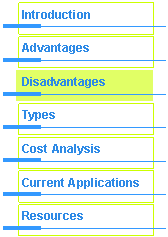
|
This page was created by:† Rey Medina & Leah Richter |

|
Disadvantages |

|
Appropriate Technology
|
|
Appropriate technology encompasses such a wide field that it is hard to describe the exact points of weakness. One disadvantage of appropriate technology is that sometimes a solution simply does not work as planned. Some solutions tried have failed because some factor was not considered or the design did not work as planned. Since it is a relatively new field of study, there is still much work that needs to be done on the most effective way to apply the resources available in the area of need. What might be very practical and cheap in one area of the world would be ridiculously expensive or not work at all in another region. Also there is the problem of the different cultures within various countries. One solution used for a village in Africa was found to be cultural repulsive to another village in the same country. Therefore, appropriate technology takes tremendous study of the regionís climate, resources, location, and people.† There are also many cases that the long term effects are unknown. There are also the problems of a sustainable solution creating other problems. For example, a micro-hydroelectric plant might be built in a remote village to provide the village with power. Each hut would own its own battery that could be charged at the micro-hydro then be taken home to provide power. Batteries, however, donít last for an extremely long time and are filled with toxic materials. What will happen with the batteries when they go bad? How will they be disposed of properly? These are issues that designers have to deal with. [3] Most appropriate technology applications are built for small scale use, that work well for small, remote villages. But appropriate technological solutions pose more problems for large scale applications. Some forms of sustainable resources are very expensive and not practical for extensive use. Therefore, the cost becomes much greater than current methods making it not as economically feasible. This is especially true for countries that are already technologically advanced. |

